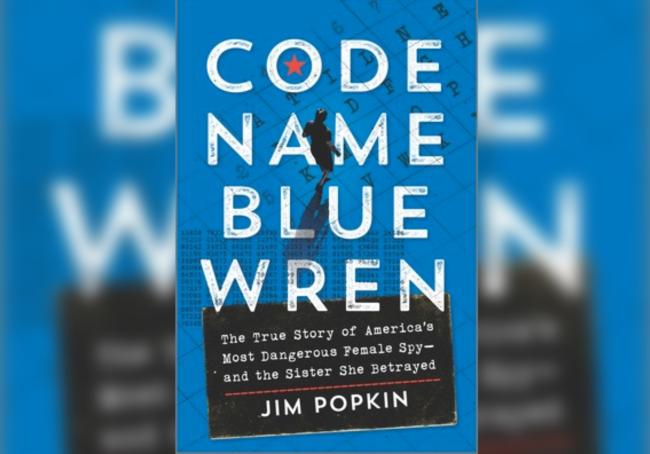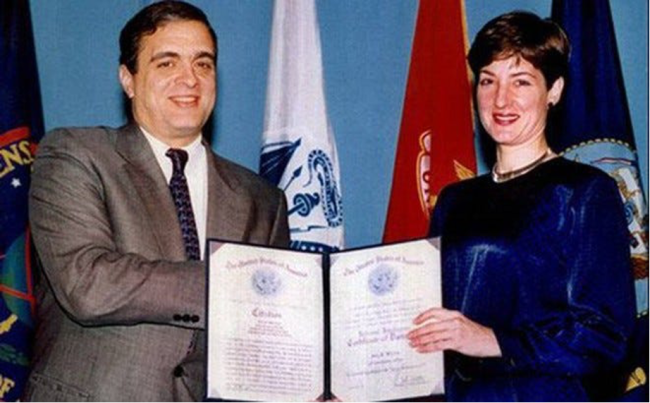
Leer este artículo en español.
This article was originally published by Spy Talk and in Spanish by La Mirada.
Ana Belen Montes, the most effective and damaging spy for Cuba known to have penetrated U.S. intelligence, was a major warrior in the long nasty war between the United States and its communist neighbor. On January 6, after serving just over 21 years of a 25 year sentence for espionage, she was released from a maximum security prison. Her release perhaps draws the curtain on the deadly clandestine conflict involving efforts by Cuban exiles and their U.S. allies to reverse the revolution led by Fidel Castro.
By the time of her arrest in 2001, Montes had been a mole inside the Defense Intelligence Agency (DIA) for 17 years, feeding U.S. secrets to Cuba during the civil wars in Central America, where Cuba and the U.S. military backed opposite sides in conflicts in Nicaragua and El Salvador. Even as the Cold War ended with the dissolution of the Soviet Union and its lifeline of economic and military support for Castro’s regime, Montes rose in rank and importance in the DIA. She became the agency’s chief analyst in charge of processing U.S. intelligence about the island, earning the sobriquet, “Queen of Cuba,” both for her unrivaled expertise and her imperious manner.
There have been worse breaches of U.S. national security, notably Aldrich Ames and Robert Hanssen, whose spying for the Soviets inside the CIA and FBI led to the deaths and imprisonment of a good number of the CIA’s Russian sources. But Montes’ spying unquestionably dealt devastating blows to U.S. human intelligence and surveillance operations inside Cuba, especially during the 1990s, when Cuban exiles based in Miami were launching what may have been their last concerted effort to overthrow Castro. Information provided by Montes blew the cover of at least four U.S. agents operating inside Cuba, according to damage assessments conducted after her arrest.
Jim Popkin, an investigative journalist and former senior producer for NBC News, tells the story of Ana Montes and the counterintelligence agents at the National Security Agency, DIA and FBI who finally caught her in his engaging and solidly reported book, Code Name Blue Wren, released only a few days before Montes was freed this month. Spy cases are notoriously difficult to write about, especially those involving spies working for U.S. adversaries. The existence of a mole inside a major intelligence agency is by definition an egregious failure, and such institutions rarely are eager to share the details of a debacle on the scale of Montes’s penetration of the DIA.
As a lead Cuba analyst in her everyday work at the agency, Montes drafted reports arguing for a softer U.S. policy toward the regime. Popkin, citing his sources, calls her recommendations “disinformation”, but—perhaps ironically—her analysis of Cuba’s deteriorated military capability and conclusion that Cuba no longer posed a significant threat to U.S. national security in the 1990s put her in respectable company. Similar conclusions would become mainstream in policy circles and lead to the eventual rapprochement with Cuba and resumption of diplomatic relations by the Obama administration in 2015.
Popkin seems to have interviewed all the major actors involved in the multiyear counterintelligence operation that —finally—led to her arrest in the days following the 9/11 terrorist attack. The decision to move against her was accelerated when FBI investigators learned Montes had been promoted and given a major role in the DIA team planning and selecting targets for the U.S. war against Al Qaeda and the Taliban in Afghanistan.
Montes was a “true believer,” to borrow the term used by one of the counterintelligence agents who caught her—which differentiates her from better known U.S. moles who turned coat mostly for money. Her parents were from modest families in Puerto Rico, and Montes began the process of radicalization in 1977 during a trip to Spain where her boyfriend was a young leftist who had experienced the worst years of the dirty war in Argentina, Popkin writes.
A gifted academic studying at the prestigious School of Advanced International Studies of the Johns Hopkins University School in Washington, she opposed the Reagan administration’s sponsorship of the Contra fighters seeking to overthrow the leftist Sandinista government in Nicaragua. A Puerto Rican classmate—who also happened to be a Cuban agent—encouraged her outrage on Nicaragua and took her to meet a “friend” in Cuba’s U.N. mission in New York. There her recruitment to work with the regime’s intelligence service was formalized, originally with the sole idea of supporting the Nicaraguan cause. Soon Montes arranged a trip to Cuba for training in her new craft. Popkin mentions that, according to evidence gathered after her arrest, Cuba helped Montes pay off student loans and buy a laptop, but otherwise did not pay her to spy.
One of the most fascinating stories in the book is that of a Cuban-American woman at the secretive National Security Agency who gathered details about the unidentified mole (who turned out to be Montes) by decrypting Cuban radio messages. For example, the messages revealed that the suspected spy had visited the U.S. Guantanamo military base at a certain date, had bought a Toshiba laptop computer, and that Cuba had paid off the agent’s college loan.
The NSA official, given the pseudonym Elena Valdez, doggedly pursued the spy chase for three years, leading to the identification of the DIA as the penetrated agency and the arrest of Montes on September 21, 2001. She first briefed the FBI, which is the primary U.S. agency in charge of counterintelligence. After two years, convinced the FBI was getting nowhere, Valdez stepped outside established procedure and, in essence, went behind the FBI’s back. She wrangled an invitation to visit DIA headquarters, and there presented her packet of decrypted messages to a secure meeting with DIA counterintelligence official Chris Simmons, who showed the kind of investigative enthusiasm she felt was missing at the FBI.
Simmons quickly spotted a clue that would upend the investigation. One of the messages said the unidentified spy had access to something called “safe” as part of his or her work in the unidentified U.S. agency. “Holy shit,” Simmons said. “SAFE” was the acronym for the DIA’s classified database of analyst reports and other investigative materials shared with the CIA and other agencies. The clue meant the spy had to be working at the DIA itself.
“You’ve been looking in the wrong place,” he exclaimed. “That person has got to be in this building.”
The breakthrough reinvigorated the official FBI investigation. The search now narrowed to the DIA staff, Ana Montes was identified from the other clues, put under surveillance, and taken into custody.
Inexplicably, Popkin omits a key player in this spy vs. spy drama. While Montes was spying inside the DIA for Cuba, the CIA also had a mole inside Cuba’s own intelligence apparatus. Rolando Sarraff Trujillo was a cryptology specialist in Cuba’s DGI, the intelligence directorate, and he knew the codes Cuba used to communicate with its spies in the United States. He had been recruited to work for the CIA sometime in the 1990s and remained in place, providing the encryption information that allowed the CIA and NSA to crack the code on intercepted shortwave messages. It was his codes that allowed Valdez at NSA to read Ana Montes communications with her Cuban handlers. Sarraff was caught by Cuba’s DGI counterspies and imprisoned in 1995.

The omission in Popkin’s book is curious, because it points to the larger context of how the decades of hostility between Cuba and the United States gave way finally in 2014 to what amounted to a ceasefire. The Obama administration negotiated a renewal of diplomatic relations, allowed Cuban exiles to send money to relatives on the island, and relaxed travel restrictions. The truce after a half century of hostility left in place the economic embargo, but introduced an interlude (albeit brief) of almost friendly relations, during which hundreds of thousands of American academics and curious tourists flocked to Cuba, before Donald Trump canceled the detente.
As part of the warming of relations, President Obama negotiated a spy swap. A U.S. government contractor, Alan Gross, who had been arrested in Cuba in 2009 for smuggling military-grade communications equipment into the country, was languishing in prison in poor health. Washington had always denied Cuba’s charges that Gross was a spy, but saw an opening to spring Sarraff. The United States was holding three men who had been arrested in 1998 as part of the so-called Wasp network, a group of Cubans spying on militant anti-Castro groups in Florida.
To break the impasse, Cuba agreed to release Gross on “humanitarian grounds” and to exchange Sarraff for the three Wasp spies held by the United States. In announcing the swap, President Obama, referring obliquely to Sarraff, said the unnamed spy was “one of the most important intelligence agents that the United States has ever had in Cuba.” More relevant to the odd lapse in Popkin’s story, U.S. intelligence officials issued a statement saying the exchanged spy’s information had led to the detection and conviction of Cuban spies working in the United States, not just the members of the Wasp network but also Ana Montes. Spytalk editor Jeff Stein, writing for Newsweek at the time, was one of several reporters to confirm Sarraff’s identity and the link between his cryptography work for the CIA and Ana Montes’ arrest.
Other than that, Popkin has produced a fine piece of reporting and writing on an intricate, and largely overlooked, spy-vs.-spy case. My only other quibble is that he gives barely a nod to the sordid history of the conflict between the United States and Cuba, marked by the U.S. sponsored Bay of Pigs invasion of 1961; the Soviet Union’s secret deployment of nuclear missiles in 1962, which brought the world to the brink of war; and dozens of U.S. plots to assassinate Castro in the 1960s. Perhaps reflecting the attitudes of his hardline sources, Popkin expresses disgust not only for Montes’ betrayal of her country but also for her leftist friends, notably a prominent School of Advanced International Studies professor whom he ungraciously dismisses as an apologist for Cuba.
Neglecting that history, he is unable to do justice to the remarkable evolution of U.S. relations with Cuba, during and after the time Ana Montes was active, culminating in Obama’s peacemaking with the post-Fidel Castro regime. Popkin’s portrayal remains stuck in the anticommunist tropes of many decades ago, when Cuba and its Soviet ally did indeed present a clear and present danger, certainly from the point of view of the United States. I admit: Mine is perhaps the complaint of a Latin Americanist, grasping for the wider framework of the spy story, rather than the book Popkin actually wrote.
That said, Popkin’s Code Name Blue Wren is unquestionably the most complete telling of this fascinating spy saga and the story of an occasionally brilliant and always morally complicated woman who decided to spy against her country. Montes has said her spying activities were “morally wrong” but that she “obeyed [her] conscience rather than the law.”
After her release, Montes returned to Puerto Rico where she said she intends to live a quiet life and try to earn a living again. Saying she would make no further public statements, she aimed an unrepentant final shot at U.S. Cuba policy, asking “Who in the past 60 years has ever asked the Cuban people if they wanted the United States to impose a suffocating embargo to make them suffer?”
John Dinges is a Former National Public Radio managing editor and Washington Post special correspondent in Chile and Central America. He is the author of three widely praised books on Latin America, including, most recently, The Condor Years: How Pinochet and his Allies Brought Terrorism to Three Continents.

